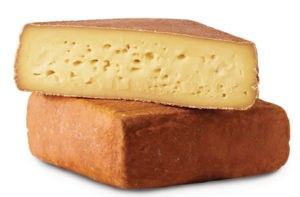
The Great 28 is featured in our Cheese+ 2017 issue. Check out 27 other pairings here.
Sake is what most Americans think of as Japan’s signature drink, but shochu is the most popular. “Traditionally, the number one drink is beer and number two is shochu,” says Michelle Hand, a certified sake sommelier who discovered the pleasures of shochu while studying Japanese in Ishikawa. Sake, she says, relies mostly on export; shochu is the people’s drink, with some 600-plus distilleries across the country.
Because it’s more widely available, shochu is often assumed to be less interesting than sake. But it can be just as compelling, Hand says. Unlike sake, which is, by definition, made from rice, shochu may be created from a wide array of starches, from barley to sugar cane. And while both begin with fermentation of a base ingredient, shochu goes an extra step: It’s also distilled. The result is a clear drink that captures the flavors of its components in delicate and fascinating ways.
To demonstrate, Hand led me to EN Japanese Brasserie in Manhattan, one of the first restaurants to import an extensive array of top-notch shochu to the US. Beverage director Yoshi Sakimoto poured a few favorites into small glasses, leaving enough room for an ice cube or a splash of water; in Japan, he explained, shochu is usually watered down by as much as 50 percent. This is another reason why shochu is so popular: Bottled at about 25 percent alcohol—only 5 to 10 percent more than most sakes—and then diluted, it’s a beverage you can drink all night. “In Japan,” Hand adds, “they say it’s good for you.”
“Health” claims aside, our tasting reveals there’s a shochu for everyone. “When I meet someone who’s unfamiliar with shochu, I often begin by asking them what they usually like to drink,” Hand says. “If it’s vodka, I’ll start them with something neutral or sweet, like rice or sugar cane. If they like gin, I’ll go for sweet potato—it has that earthier flavor. If they drink whiskey, I’ll do a barrel-aged one.”
At EN, Sakimoto finds that shochu is versatile at the table, too, and sneaks it into tasting menus with everything from raw fish to red meat dishes. That adaptability translates well to cheese, even if it’s not a time-honored combination. Here are some of our top pairings.
Sweet Potato Shochu

Meadow Creek Dairy Grayson
Sweet potato is one of the most popular base ingredients for shochu—but we’re not talking about the big orange tubers that grace Thanksgiving tables. The Japanese sweet potato is earthier and less sugary, qualities reflected in this deeply savory shochu. It’s a terrific contrast to the sweet milkiness of a snowy Délice de Bourgogne. At the same time, shochu doesn’t back down from funky cheeses, either, such as Grayson—a washed-rind cow’s milk wedge.
Recommended Pairings:
Fromagerie Lincet Délice de Bourgogne + sweet potato shochu
Meadow Creek Dairy Grayson + sweet potato shochu
Sesame Shochu
“Sesame shochu is rare, but it’s the first one I fell in love with,” Hand says. It’s redolent of lightly toasted sesame seeds, and that nutty character makes it a natural with aged Alpine styles like Chällerhocker or Tarentaise from Spring Brook Farm in Vermont.
Recommended Pairings:
Käserei Tufertschwil Chällerhocker + sesame shochu
Spring Brook Farm Tarentaise + sesame shochu
Barrel-Aged Barley Shochu
While barley is the most common base ingredient for shochu, only a few are aged in oak barrels. The vessel gives shochu a deep, more complex flavor with brown sugar overtones and vanilla sweetness. It’s delicious with dense, milky Chabichou du Poitou, the two melding into a caramel-like sensation. The wood also enriches the shochu enough to stand up to Rogue Creamery’s crumbly, bacony Caveman Blue.
Recommended Pairings:
Chabichou du Poitou PDO + barrel-aged shochu
Rogue Creamery Caveman Blue + barrel-aged shochu
Feature Photo Credit: Nishihama/Shutterstock.com




